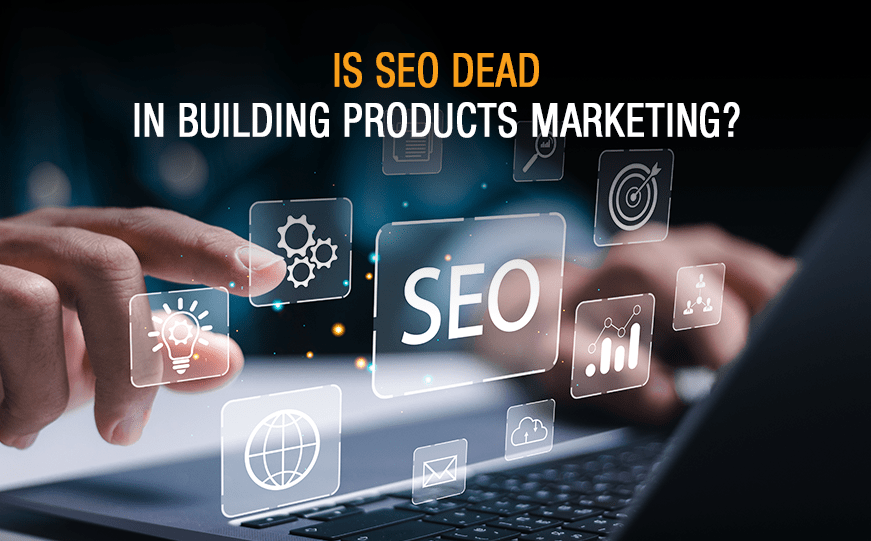The question hangs in the air like dust at a demolition site: “Is SEO dead in building products marketing?”
With the rise of AI-powered platforms like ChatGPT, Perplexity and Genesis… it’s a question that marketing leaders, sales executives, product managers and business development professionals – across the building products industry – are asking today.
But let’s be clear: this isn’t about burying SEO.
It’s about understanding its evolution. And reframing how it fits into a modern, AI-impacted marketing mix.
SEO’s Legacy Role in Building Products
Historically, SEO has been a powerful, passive lead-generation tool in the building products sector. It was the silent workhorse. Essential for reaching in-market trade professionals – builders, architects, contractors – as well as an important cohort of building owners who participate in construction solutions research. Keywords, optimized product pages, how-to blogs and spec sheet downloads all fueled the funnel quietly. It was the foundation upon which many brands built their online presence… a way to be found when prospects were actively searching.
What’s Changing in the Digital Landscape?
Certainly, the digital landscape is currently undergoing a seismic shift. Search engine results pages (SERPs) are increasingly dominated by paid placements… pushing organic listings further down. Platforms like Facebook, LinkedIn and Instagram are limiting organic post visibility. In doing so, making it more challenging to reach audiences without paid promotion. And then there’s generative AI – offering instant answers and often bypassing the need for click-throughs – to websites.
Passive + Active: A Balanced Marketing Approach
So, is SEO dead? Absolutely not.
SEO has always been a crucial way for marketers to capture in-market buyers. It was never enough to stand on its own. Though SEO (passive/inbound) is evolving, it still matters… but now it’s even more critical that other channels and tactics step up to provide support and overall effectiveness. SEO must be paired with active outreach: email campaigns, LinkedIn thought leadership, webinars, podcasts and channel media. Think of it this way: a blog optimized for SEO can also fuel an Enewsletter. It can be repurposed for LinkedIn posting. And be featured on a podcast. The content becomes a multi-purpose tool – working across various channels – to maximize reach and engagement.
The Power of Commercial Insight and Personal Value
To truly cut through the noise, building product marketers must go beyond basic keyword-optimized content. Research from the CEB Marketing Leadership Council, in partnership with Google, highlights the importance of combining Commercial Insight and Personal Value.
Commercial Insight teaches an audience something new about their own challenges and connects them uniquely to a particular solution.
Personal Value content builds trust, emotional resonance and loyalty – especially critical – in B2B marketing. This is content that’s not merely searchable. But rather, worth finding.
Brands That Do It Well
Several brands are already mastering this approach. James Hardie together with Trex have successfully used SEO, content hubs and influencer videos to dominate homeowner and pro segments. LP Building Solutions has been investing in SEO-driven blogs and builder webinars. These brands understand that a multifaceted approach is key to staying visible and relevant.
Four Truths Marketers Should Accomplish Now
So, what “next steps” should marketers in the building products industry prioritize? First, audit existing SEO strategies. Confirm ranking results for longtail keywords and questions that soon will be answered directly by AI. Second, create thought leadership narratives that address real-world trade pain points. Third, repurpose content: blogs → LinkedIn → webinars → email → podcasts. Fourth, invest in focused, strategic content…over high-volume content.
The Importance of Specialization in Building Materials Marketing
For marketers responsible for B2B building product brands, these shifts present both challenges and opportunities. Understanding the nuances that exist within the channel is crucial. It’s not just about knowing how to write a blog – or posting a social media campaign – it’s about understanding the complex relationships between manufacturers, distributors, contractors, architects and homeowners. And familiarity with the language of the trade. The pain points of the professionals. And the decision-making processes leveraged in specifying and purchasing.
The complex – integrated infrastructure – that supports building materials marketing.
Brands that excel in this space are those that can provide not just articulated features and benefits. But rather, deep industry insights. Brands that identify the right keywords – who develop content that resonates with target audiences – and create integrated campaigns that leverage multiple channels.
Navigating the evolving digital landscape requires confidence… and leadership ahead of trends. Adapting to changes in search algorithms and AI technologies.
The Role of Installed Building Products in Modern Marketing
Consider the role of installed building products. Unlike consumer goods, most building products require professional installation… adding layers of complexity to the marketing process. It’s not just about prompting someone to consider a product – it’s about convincing them that it can be installed – efficiently and effectively.
Yes, marketing involves creating content that supports the installation process… such as detailed manuals, how-to videos and training materials. It also involves nurturing relationships with installers and contractors – who can become powerful advocates – while providing testimonials in case studies and project profiles. By providing these influencers with the right tools and support, building product brands can ensure that product solutions are installed correctly. And building owners or facility managers are satisfied, with the results.
The Future of Builder Products Marketing
Looking ahead, the future of builder products marketing will be defined by a blend of technology and human connection. AI will continue to play a significant role in content creation and distribution – yet it will never replace the need for authentic, insights – that address real-world challenges. The most successful marketing communication leaders and the agencies that can bridge this gap will leverage technology while also understanding what helps to motivate human instincts.
Is your SEO content helping you own the conversation?
Or is there a concern that it is simply showing up, a bit too late?
Let’s evaluate your current strategy and consider how to better blend passive and active approaches… to maximize your reach and impact. Send an email to Steve at sk@kleberandassociates.com to schedule a complimentary strategy session. Or visit kleberandassociates.com for more insights and case studies on content marketing and commercial insight services.




